
Jill Baker Gower is an artist, metalsmith, and educator. Her jewelry, often based on the female experience, has been widely exhibited and printed in publications such as Metalsmith magazine and the book 500 Enameled Objects. Gower is also the recipient of the 2015 New Jersey State Council on the Arts Individual Artist Fellowship, and recently had the show called Dermal at Heidi Lowe Gallery.
Olivia Shih: Could you tell the story of how you became interested in making jewelry? How has your background and education influenced you?
Jill Baker Gower: I have been making jewelry for as long as I can remember. I started working with seed beads around age eight. I was a very patient child and would spend hours at a time creating beadwork, macramé, and crochet by studying patterns and instructions in library books and magazines. In my teens I would go to the public library and check out stacks of craft how-to books published primarily in the 1960s and 70s. I really didn’t have a lot of instruction as to where to look. I spent AP art classes in high school making crocheted and beaded objects on my own with very little instruction or direction. It is from there that I learned basic skills and how to follow patterns and appropriate them for my own creations. I have always been good with my hands and especially attracted to working small.
I went to undergraduate school not really knowing what I wanted to major in. I decided on art education and took many ceramics classes. I didn’t know that I could major in metals/jewelry or pursue it at the college level. When I took my first metals class at the University of Wisconsin–Madison with Fred Fenster, I was immediately hooked. It was something that I not only loved, but I excelled in. I had no idea where it would lead or that it would become one of my life passions. I wasn’t really aware of the contemporary jewelry world until graduate school at Arizona State University, where I studied with David Pimentel, Masumi Kataoka, and Becky McDonah. In graduate school, I was greatly influenced by my peers and surroundings. From here I became interested in the body, beauty, glamour and how it is portrayed or displayed in the media and society for source material or inspiration.
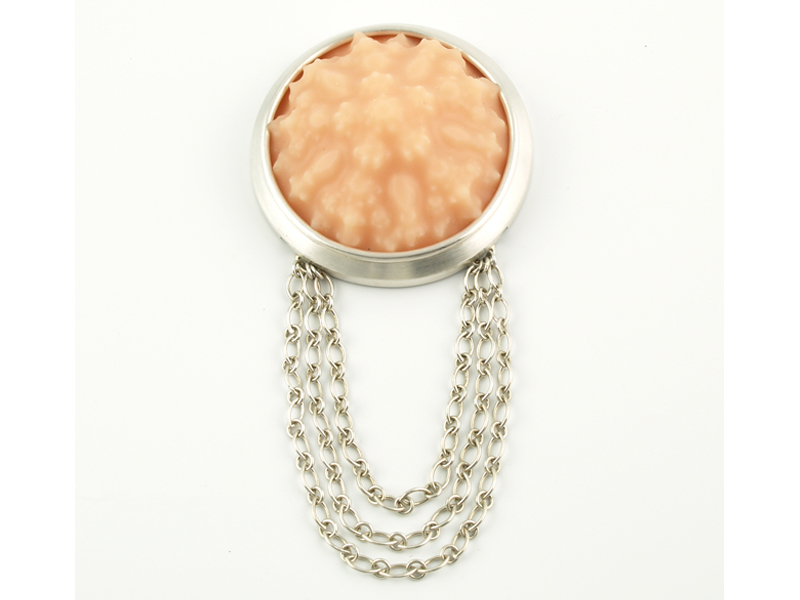
As you’ve stated in your artist statement, “the female experience is a reoccurring theme” in your work. What does the “female experience” mean to you?
Jill Baker Gower: When referring to the “female experience” in my work, I’m speaking about my personal observations, involvement, or reaction to experiences that I have had throughout life. One “female experience” that feeds my work is that of the constant pressure to fit into societal demands: physical standards, beauty ideals, the bombardment of sexy imagery, or women used as sex objects. This speaks to anything from implements for beautification, unavoidable advertisements, miracle pills, lotions, undergarments, beauty injections and implants, and any other beauty aid or fix that women and girls are exposed to on a daily basis. My personal experience with this involves both love and hate. I find myself often pulled into glamorous images of beautiful women and luxurious packaging of beauty products, but at the same time feeling some sort of guilt for wanting or liking these things! Why am I drawn to them when sometimes they are just so ridiculous?
Another “female experience” my work references is women’s health, the female body, its shape, its transformations, and reproductive capabilities. My experiences include invasive medical exams from a young age, obtaining and using contraceptives, pregnancy and childbirth, breastfeeding, motherhood, and the societal expectations and pressures that come from these acts. As with most women, I have had my share of awkward doctor’s visits with uncomfortable procedures, some of them explained to me in advance and some of them not. I was fortunate to give birth to two children all natural with no drugs by choice. I’m now educated on the options women have in childbirth and the side effects that can come along with drugs and other interventions that are sometimes unnecessary. I’ve also experienced breastfeeding in public and acknowledging that this sometimes make others uncomfortable. It’s ironic to sit covered up while nursing in front of adjacent images of sexualized nearly nude women at Victoria’s Secret. Learning to make informed choices with my health and my body has been a frustrating and at times shocking process. These experiences come into my work through the use of female body forms, fleshy shapes that are sometimes restricted by metal, and through material and color choices.
A third “female experience” that influences my work is that of gender categorizing or character portrayal of women. Here I’m speaking to gender differences in marketing of anything from Legos to motorcycles to toothbrushes, the character portrayal of women in advertisements, cartoons (I have a five- and two-year-old boy, mind you), video games, TV shows, and also portrayal of domestic women in the family household. I find humor in the over-generalized stereotypes, but also fear what my children are taking in through all of this.
The final “female experience” I utilize in my work is handicrafts, including crochet, sewing, knitting, lacemaking, and their consideration as primarily feminine both in the act of creating and as a design element. I use sheet metal etched with lace patterns and pair actual crochet with metal or flesh-toned rubber. It adds contrast, color, and texture but also references femininity.
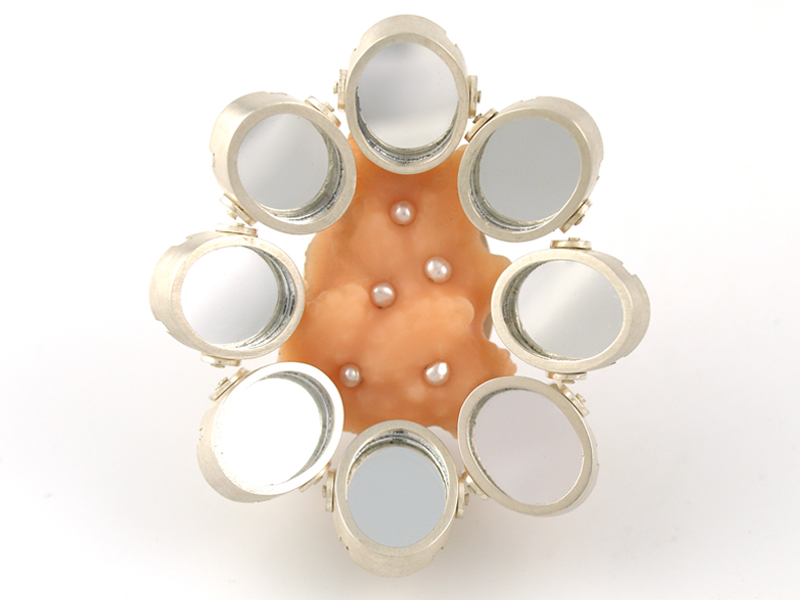
In Fleshgem Collar, the skin-toned rubber takes on the form of faceted gemstones. How did you decide to pair a fleshy object with gemstones?
Jill Baker Gower: To me this seemed like an obvious pairing. Some women (or media-portrayed women) are attracted to large gems. I aimed to create a collar that would look like gem-shaped growths or medical or decorative implants of some kind. The size of the piece is meant to be humorous and a bit strange or disgusting. Its fleshy drips look as though the piece might still be oozing, melting, or growing. This piece comments on body implants, but also on society’s obsession with bigger is better, both for the gem and for certain body parts. With medical advances, skin growths such as this might be as easy as getting a tattoo or a piercing; instead of a diamond necklace, your skin and flesh is actually gem-shaped. With technology, I don’t feel as though this is very far-fetched.
Dermal, the title of your exhibition, is most present in your wall mounts, where every little pore and wrinkle of skin is magnified and put on display in skin-toned rubber. Why choose this specific texture for the wall mounts?
Jill Baker Gower: Actually, I have to admit that this final solution came from an initial unplanned disaster. The first goal for the wall mounts was for them to be blemish-free and entirely smooth, perfect skin. After slathering automotive filler onto my foam molds and sanding, and slathering more, and sanding, I came to the realization that the smooth final finish was just not happening. The textured pore rubber flesh is a happy accident, the result of some creative problem-solving, and turned out to be in my opinion more successful than if the mounts had been smooth and blemish-free. The wrinkle- and pore-entrenched skin next to the smooth cast Fleshgem pieces adds contrast and more absurdity. The imperfect skin has protrusions that you just want to pick at, such as a scab or a skin tag. With the mirrors that are in a few of the brooches, viewers can see their own reflection in the work directly next to enlarged pores and wrinkled flesh.
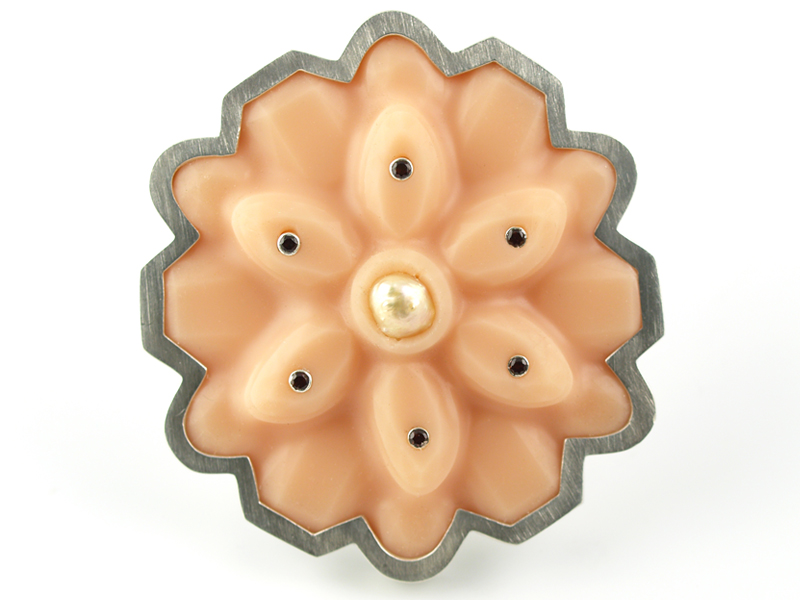
Little bits of flesh-like rubber are secured with traditional jewelry settings, and I can’t help but feel as if the flesh is entrenched in a piece of jewelry. Do you think flesh can function as adornment?
Jill Baker Gower: Yes, I think flesh can function as adornment. It has been doing that for thousands of years. Just think about lip plates, earlobe stretching, scarification, tattoo, and microdermal implants. Most types of body modifications are still being done today somewhere on Earth.
With the traditional jewelry settings, I’ve created a fleshy gem shape that, if not set or entrenched in some way, would simply not look finished. Just as beauty products and glamorous advertisements have physical perfection as a requirement, so do I in my work. I’ve concealed rubber edges, made the surface beautiful, combed and refined, primped, and glamorized the rubber flesh. I’ve covered up the blemishes, nipped, and tucked. I simply can’t make work that’s not beautiful.

Your work is often humorous or even absurd. Do humor and absurdity play a role in your own life?
Jill Baker Gower: While I was growing up, my dad was always cracking silly jokes and making humorous comments daily. I love to laugh and surround myself with others who have equally good senses of humor, ha! One of the reasons I am attracted to my partner is because he adds humor to my life and is able to lighten a mood or change an attitude by being his spontaneous, rebellious, against-the-rules, prankster self. I am quite the opposite. I look for humor all around me, but I’m a pretty introverted, follow-the-directions, type A person who needs to find an outlet elsewhere! My kids keep life pretty humorous. With two- and five-year-old boys, there are many absurdities, whether you want them or not, and of course you have to try your best to add humor to the every day of daily life that comes with having two young children.
If I’m going to be in my studio, I want to have fun while I’m there, I want keep up that desire to be in the studio. I don’t want to over-conceptualize my work, it’s humorous, beautiful, and hopefully thought-provoking. I want it to entertain me, and it needs to in order for me to be productive.
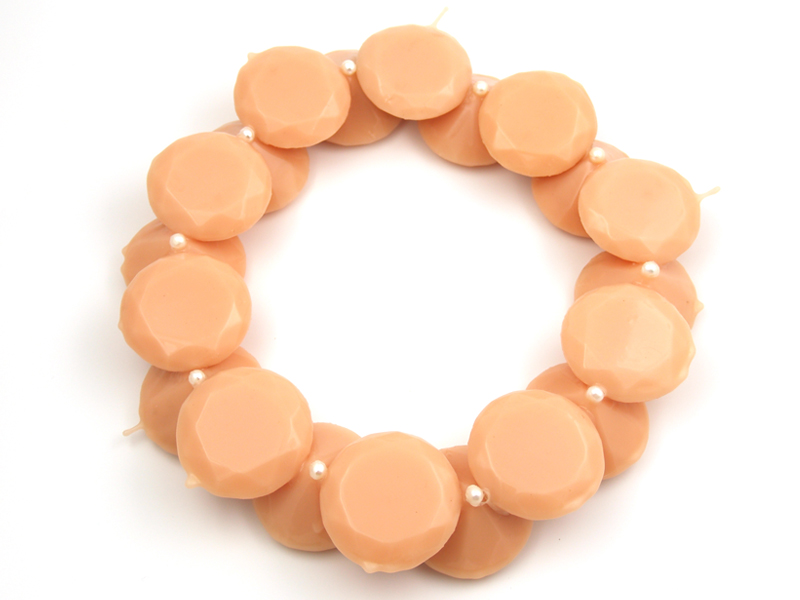
Could you name three emerging artists whose works excite you?
Jill Baker Gower: I think that’s a difficult question. Aren’t we all trying to emerge from something or into something new? I consider myself emerging. I think that the field of art jewelry in general is still emerging.
There are many great “emerging artists” coming out of art school, but I’d like to mention a couple other artists whose work I’m impressed with. I think they are all emerging in some way, whether it’s into a different body of work, a different audience, or into the fine art world. I’m interested in work that’s meticulously crafted, complex in design and construction, shows variety, and is innovative.
Jennifer Trask
I have loved her work since graduate school. I’ve never met her, but I’m consistently blown away when I see new work. I’m interested in her use of found materials and her decorative and biological inspirations.
Stacey Lee Webber
Stacey is a hard-working Philadelphia-based metalsmith who makes sculpture, objects, and jewelry. She’s a maker and designer and is emerging more so into the commercial realm, kicking butt selling her work. Her work is insanely complex and the attention to detail is amazing.
Amber Cowan
Amber is a Philadelphia-based glass artist whom I had the opportunity to meet in person. Her work consists primarily of gorgeous flameworked assemblages of monochromatic discarded, recycled, or vintage found colored glass.
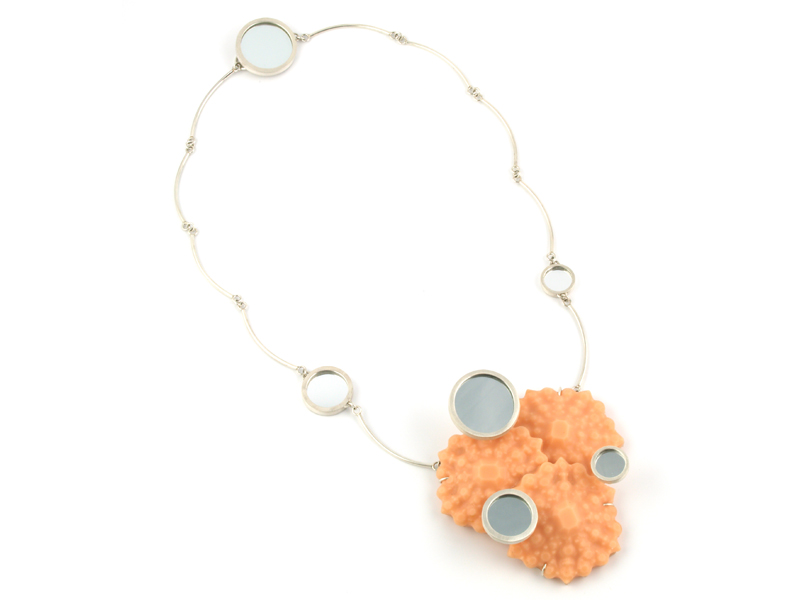
Have you heard, seen, or read anything lately that you can recommend?
Jill Baker Gower:
Read:
-A book I go back to again and again: A Natural History of the Senses, by Diane Ackerman
-A book that was recently recommended to me and I’m not finished with yet, but I am enjoying: The Power of Glamour, by Virginia Postrel
–Beauty Junkies: Inside Our $15 Billion Obsession with Cosmetic Surgery, by Alex Kuczynski
–W Magazine
Heard:
-Kurt Vile
-Tame Impala
Thank you.
AJF has decided to begin posting the prices of pieces in the gallery shows we are highlighting each month. The price range for the work in Dermal is $1,400 to $2,600.





